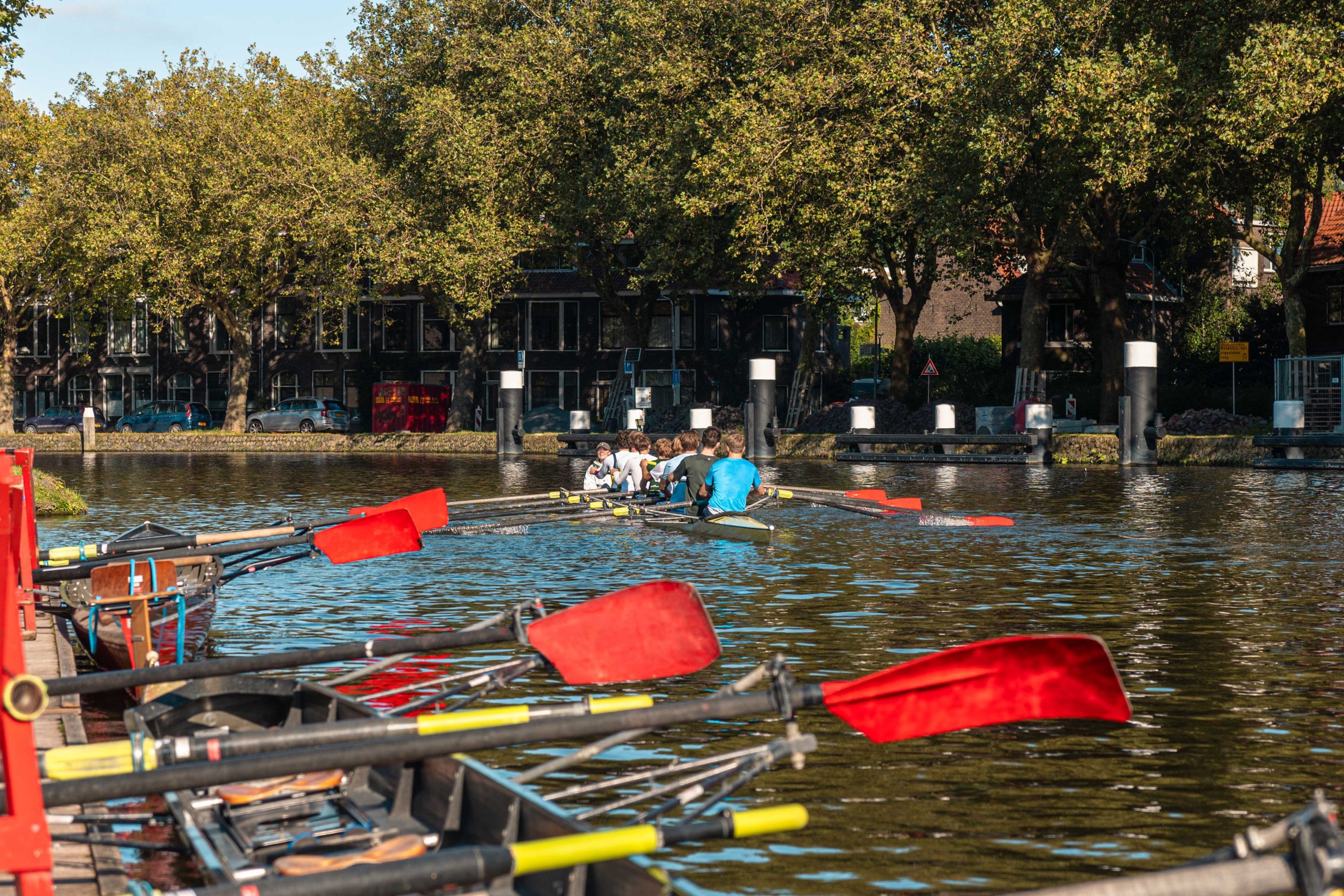Ten rowing associations are signing a new cooperation agreement with inland shipping companies and the Province of South Holland for improved safety on water. What will the covenant mean in practice?
To improve visibility on the water, rowers at the front or back of the boat should wear light colours. (Photo: Thijs van Reeuwijk)
A large barge is hard to manoeuvre, has limited visibility, and needs a long stretch to brake. The association with light, fast and flexible rowing boats is not an obvious one, but as they share the same inland waters, they have to deal with each other. For the TU Delft DSRV Laga and DSR Proteus-Eretes rowing associations, this inland water is the Delft section of the Schie River. The covenant of the province, that was signed on 26 September, covers all the shared inland waterways in South Holland.
South Holland is the first province where agreements like these are being made between rowers and Schuttevaer, the professional shipping association. Martin van Veen, Laga’s Chair, says that the KNRB rowing union is promoting the covenant among its members as a model for the whole of the Netherlands.
Rowers and skippers
In an explanation to Delta, the spokesperson for the Province, Frank Beijen, writes that ‘We received various reports about near collisions. They are often caused by a combination of circumstances or when rowers underestimate the risks. They may be just ahead of a barge or try to overtake it shortly before the waterway narrows, or they are in the blind spot of an inland shipping barge (rowing just in front of the ship). Apart from the fact that the skipper cannot see the rowers properly, he is unable to stop on time or move out of the way if something happens to the rowers. This is dangerous. Rowers are vulnerable in shipping passages. We want them to be aware of this.’
Marieke Vassen, Materials Commissioner at Laga, says that “I think rowers do know this, but the message needs to be repeated once in a while. I gave a talk for the whole association yesterday. Think about your visibility. You can help avoid accidents if you wear a white shirt instead of a black one so that you are more visible. The reception committee also makes this clear to all 250 first years. If someone still wears a dark shirt on the water, we say something about it.”
Mees Rapp, External Relations Commissioner at Proteus-Eretes, says that “Not that much has changed compared to the previous version of five years ago.” But he does think that the covenant helps improve safety on water. For the rowers, it means that they make sure they are well visible on the water and that they are regularly reminded about potential dangers. “We issue a blog post about this once in a while, for example saying that it’s getting dark earlier so make sure you are visible and think about your safety. That sort of reminder.”
Schuttevaer
What has changed compared to the previous covenant? The Province’s spokesperson, Beijen, says that skippers need to know what they can expect in the area around Delft, such as narrow waterways, a lot of bridges and a lot of rowers, so they should be extra careful. Professional sailors also need to take account of rowers and reduce their speed.
The covenant states: ‘Schuttevaer makes its members in particular aware of the risks involved in overtaking in narrow channels and around bridges.’
Schuttevaer also encourages the use of cameras on the bow or in the mast to give skippers clear views and to minimise the blind spot.
Frequently first years
From conversations with skippers, Laga Chair Martin van Veen concluded that it is often the first year teams that experience dangerous situations. “Older rowers have a better idea what they can do. First years do not have much of an idea of what they are doing. If the team is under pressure and the helmsman does not give clear orders, this can cause confusion and result in them getting closer to a barge than they want.”
In more senior teams, irritations are often around overtaking which can be risky as Van Veen knows. “It usually goes well, but I have experienced that we went much faster than the barge, which is what you want. But when we overtook, we landed in the high bow wave and our boat filled with water. It flooded and we had to wait. Overtaking is a complex manoeuvre involving location, the difference in speed, the particular circumstances, visibility and other traffic.”
Overtaking is a complex manoeuvre involving location, the difference in speed, the particular circumstances, visibility and other traffic
“The relationships with the professional skippers are good,” says Mees Rapp (Proteus-Eretes). The dialogue around the covenant led to greater understanding between them. A coach on a bicycle gives the skipper a thumbs up. This sort of thing keeps the relationship strong. “The shipping companies take our safety seriously. We actually now have more problems with recreational sailors. Yachts and motorised dinghies often underestimate their speed and the waves. Unfortunately they do not have an umbrella organisation that we can talk to.”
Just before leaving Laga, a narrow boat docks with two rowers. Both are wearing dark blue shirts. Despite all the efforts, the ‘KNRB Richtlijn Zichtbaarheid’ (2021, the Royal Dutch Rowing Association’s guidelines on visibility) is not yet being followed by everyone. Van Veen calls this an unfortunate coincidence “as it is going well in general”.
Do you have a question or comment about this article?
j.w.wassink@tudelft.nl


Comments are closed.